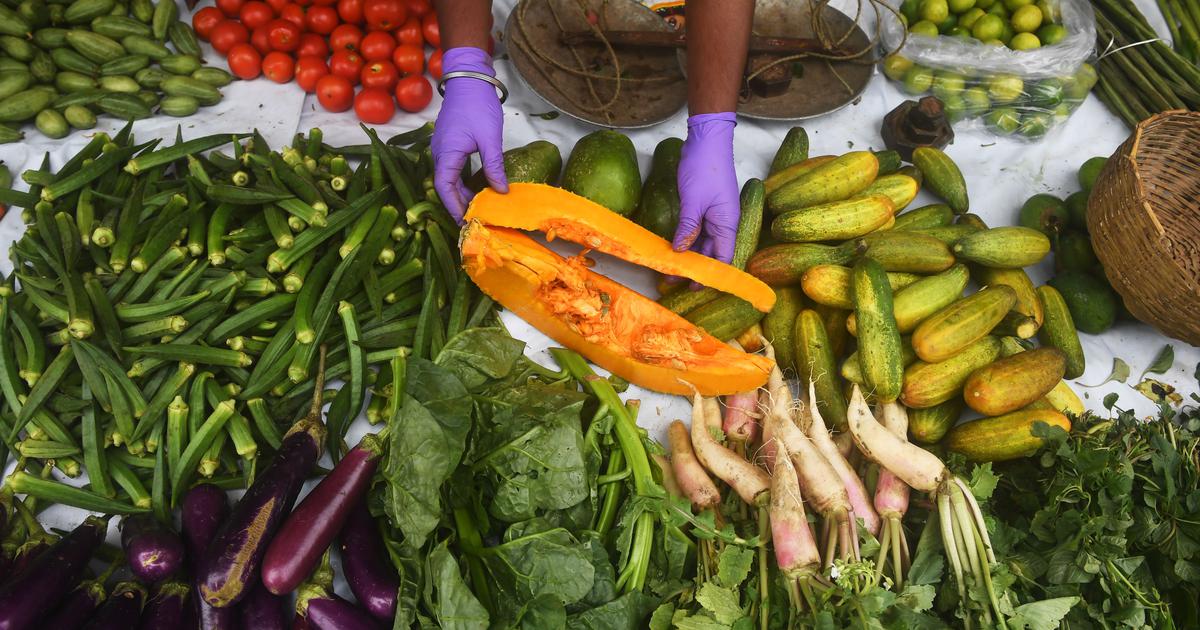One machine cleans the incoming carrots with water. The next polishes them, removing the stringy fibres. The last one gives the carrots a final wash. But those are only steps two to four. The process has already started by manually sorting the carrots according to size and shape. Before they are ready to be packed into transparent plastic bags and sent out to the shops, the vegetables will be ozone-washed to kill pesticides on the surface.
These Grade A hyper polished carrots are only one example of the push by food businesses to brand fruits and vegetables as “safe”, “organic” or “good”. Their aim? To assure discerning consumers that they are getting the very best produce.
As World Food Safety Day is marked on June 7, it provides the opportunity to take a look at what is deemed to be good food.
In India, that question is political and complicated because access and consumption have been shaped by historical caste and class practices. For their part, modern agri-businesses spotlight aesthetics, branding and traceability as safety. This shifts discussions on good food away from possible policy reform in agricultural production that could benefit farmers and consumers alike.
Grading process
Academic literature shows that consumers are being trained to desire a particular type of product. Because of the way in which consumers pick, select and buy food, farmers who are part of these supply chains are subject to strict grading criteria. Grading is an old practice that kept rotten or worm-ridden food out of agricultural markets. But now, it is used to reject fruits and vegetables that simply look a bit out of shape.
“Even if it’s a bit out of shape, they [the middlemen] say – it must be of the same size,” complained a farmer in North Karnataka as he described grading standards he faces in selling his cucumber harvest. “This is the trouble. If a cucumber comes out fat, they won’t take it.”
It is the same story for purple brinjals. “They have to be between 250 gms-500 gms,” the farmer said. “If it is 550, it will not do.”
It’s not only a matter of weight, but also aesthetics. “There should be no line on the brinjal,” he said. “It should be very clean and tidy but it is not like that. It is not a material which can be produced in a factory where an AC or generator is running.”
Grading involves heavy capital investments that farmers and cooperatives cannot afford. In such cases, a middleman or an agri-business becomes necessary to market the farmer’s produce. This creates an unequal relationship favouring the middleman because they feel that they have changed consumer perception, and therefore have a greater say in what is sold.
These unrealistic standards mean that a great deal of produce is classified as grades B and C, earning farmers lower rates. Some produce may be discarded entirely.
![Credit: Maxpixel [Licensed under CC BY CC0]](https://sc0.blr1.cdn.digitaloceanspaces.com/inline/vwygxljrji-1591457687.jpg)
Traceability
The requirement for traceability results in packaged produce containing information about origin and production practices. It allows a consumer to scan a QR code on the product to find out the farmer’s name and location, and the type of seeds used. They could also learn more about production practices.
For farmers and businesses in the supply chain, things more complicated. They may have to use technologies such as blockchain to track data at different points in the chain. This increases transparency and accountability, and hence the acceptability of produce from small farmers.
But these practices involve heavy investment, not only to set up but also for regulation and monitoring. Part of this cost may be passed on to the farmer, who is forced to follow increased record-keeping requirements or meet production norms for which they do not receive enough external support and inputs. Farmers who cannot undertake these practices are forced out of the loop.
Making food safe for all
The criterion common to all these practices is the interest is making food safe. But sometimes this food comes at a high cost. Some of this produce may only be sold in high-end retail stores or at high prices to consumers who are both discerning and wealthy. These practices take away the attention from possible policy interventions in production practices that are chemical intensive, destroy soil organisms, pollute water sources, and hurt the health and safety of people and animals.
We need a commonly accepted definition of good food that is universally accessible. It must focus on underlying production, health and safety concerns, rather than setting difficult standards and using expensive, exclusionary technologies. That means that we must rethink what food safety means to us, in addition to pushing for policy reform.
The Pesticide Management Bill 2020 is an important step in this direction. It does not make food production solely organic, which an important goal to be pursued. It aims to make the use of pesticides safer for humans and animals. It also aims to maintain biodiversity as well as ecological stability, while spotlighting traditional knowledge around pest control practices.
Kisan Swaraj Network and Pesticides Action Network India have noted inadequacies in its framing. Independent oversight, reviewing pesticide usage, farmer compensation and redressal, and traditional knowledge in pest management need more emphasis. If accounted for, the Bill will go a long way in making good food a more egalitarian project, one based on a premise of universal access and ecological sustainability.
Natasha SK is a Post-Doctoral Fellow at the NTU Institute of Science and Technology for Humanity at Nanyang Technological University.
Some of the research for this article was conducted by a team of which the author was a part, at the Indian Institute for Human Settlements, for the Hungry Cities Partnership. The author is grateful to Keerthana Jagadeesh and Rekha Raghunathan for their inputs.










